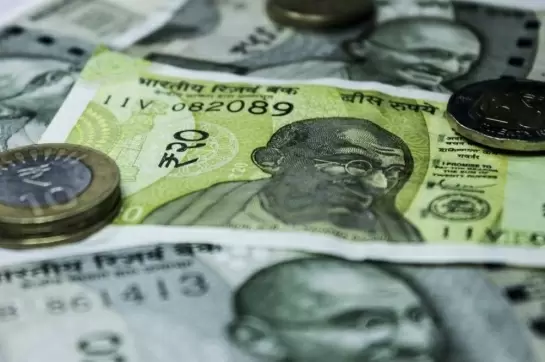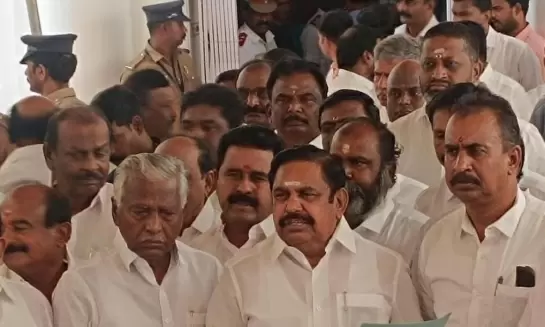Credit growth rate of banks slows down
12-October-2019
Indian banks credit growth rate, for the first time this fiscal, slowed to single digit at 8.8 per cent to Rs 97.71 lakh crore during the fortnight to September 27, according to the Reserve Bank of India supplementary data.
Throughout this fiscal so far, credit growth has been in the low-double-digit. This reflected severe economic crisis arising from both structural and cyclical issues and a massive fall in consumption demand. Indian banks' credit growth rate, for the first time this fiscal, slowed to single digit at 8.8 per cent to Rs 97.71 lakh crore during t anks' cr he fortnight to September 27, according to the Reserve Bank of India suplementary data. During the same period, deposits climbed 9.4 per cent.
Outstanding loans rose Rs 596.53 trillion ($8.40 billion) from a fortnight earlier to Rs 97.71 trillion as on September 27.
Non-food credit gained Rs 64.30 billion to Rs 97.11 trillion, while food credit fell Rs 46.51 billion to Rs 600.85 billion while bank deposits grew Rs 1.83 trillion to Rs 129.07 rupees in the two weeks ended September 27.
Throughout this fiscal so far, credit growth has been in the low-double-digit. This reflected severe economic crisis arising from both structural and cyclical issues and a massive fall in consumption demand.
The credit disbursal to corporate sector was not an ncouraging trend as the overall, financial flows to the commercial sector in 2019-20 so far (up to mid-September) have been lower than in the same period last year due to a decline in funding from banks and lower funding from non-bank sources. Among domestic non-bank sources of funding, public issues of equity and privateplacement increased significantly. Among foreignsources, both external commercial borrowings andforeign direct investment (FDI) registered sharp increases.
The total flow of funds from banks and non-banks that include public issues, commercial papers (CPs), external commercial borrowings (ECBs) and foreign direct investments (FDIs) has been reduced by 87.63 per cent to Rs 90,995 crore over the first six months (April-September) of 2019/20. The credit flow decline is drastic as it fell from Rs 7.36 lakh crore for the corresponding period of 2018/19, according to the Reserve Bank of India's (RBI) monetary policy report.
Non-food credit flow from banks to the commercial sector also declined, from Rs 1,65,187 crore to a reverse flow of Rs 93,688 crore to the banks. Net issuance of commercial papers (CPs) subscribed by non-banks fell from Rs 2,53,669 crore to Rs 19,118 crore by mid-September 2019.
The commercial sector does not include farming, manufacturing and transportation.
Karthik Srinivasan, Senior Vice President, Group Head - Financial Sector Ratings told IANS The decline in funding to commercial sector during H1FY2020 is largely driven by scaling down of the loan book by non-banks because of their funding constraints driven by increased risk aversion of lenders and investors to non-banks, even though credit flow from banks to non-banks has remained positive during this period.
Additionally, the reduction in exposure to infrastructure sector apart from seasonal decline in food processing, textiles and metal sector led to a decline in the outstanding credit to large industries from banks , he said adding the growth in credit is possible in H2.
We expect the bank credit growth to rebound during H2FY2020 given the seasonality in credit demand is higher in the second half. Even in a scenario of ~10.5% to 12.5% YoY growth in bank credit outstanding, given the challenges faced by non-banks, the overall incremental credit flow to the commercial sector from domestic sources is likely to decline by 10-15% during FY20, however the same is likely to be largely offset by an increase in external commercial borrowings.
Over the first six months of 2018/19, the flow of funds stood at Rs 1.85 lakh crore. There is a negative flow of Rs 1.28 lakh crore for the current six months of 2019/20. It shows the funds have gone back to banks because redemptions were higher than loans extended during the period. RBI report also says that the slowdown in the bank credit was led by public sector banks (PSBs). The PSBs have been facing deterioration in the asset quality, while the private banks are cautious in lending to large projects or infrastructure companies.
"Among domestic non-bank sources of funding, public issues of equity and private placement increased significantly. Among foreign sources, both external commercial borrowings and foreign direct investment (FDI) registered sharp increases, " the RBI said in its Monetary Policy Report (October 2019).ECBs rose from an outflow Rs 653 crore to a flow of Rs 54,073 crore and FDI from Rs 106,961 crore to Rs 152,119 crore during April to mid-September, according to the RBI data.
"Overall flow of financial resources to the commercial sector moderated mainly due to reduced credit offtake from banks reflecting weak demand and risk aversion," the central bank said. The RBI had cut the real gross domestic product (GDP) growth for 2019-20 to 6.1 per cent from 6.9 per cent in forecast in August, reflecting the ongoing slowdown in the economy.Credit growth to services has decelerated sharply since January 2019.
Of the incremental non-food credit flow during the year (August 2018-August 2019), personal loans accounted for the largest share, followed by services and industry. Within personal loans, credit offtake has been broadly concentrated in two segments — housing and credit card outstanding
The commercial papers (CPs) that were a major source of funds for the corporate sector including NBFCs have also witnessed a steep decline. Take, for instance, the CP issuance fell from Rs 2.53 lakh crore in 2018/19 to Rs 19,118 crore in 2019/20. The investors such as mutual funds, insurance companies and HNIs are cautious in parking money in CPs. In addition, the CP rollovers that were common during pre-IL&FS phase are also shut.
As the bank credit and CP market are shut for NBFCs, the fund flow from NBFCs has also turned negative. It has fallen from Rs 41,200 crore in 2018/19 to negative Rs 1,25,600 crore in 2019/20. This negative flow reflects in the numbers of many sectors, especially two-wheeler and three-wheeler that NBFCs had been supporting in the past. They also supported the non-salaried segments, especially self-employed people or those with irregular income.
In the credit market, offtake during the year (up to mid-September) has been muted; both, low momentum and unfavourable base effects dragged down non-food credit growth .The seasonal decline in credit during Q1:2019-20was more pronounced than in the corresponding quarter of the previous year. The offtake during Q2 (up to mid-September) has been subdued as compared with the corresponding quarter of the previous two years, RBI said.
While credit growth to agriculture and personal loans remained broadly unchanged in the last one year, credit growth to industry moderated in the last four months
after accelerating continuously between August 2018 and April 2019. Credit growth to services has decelerated sharply since January 2019 .
A combination of domestic and global headwinds has depressed economic activity, especially in terms of aggregate demand. The near-term outlook of the Indian economy is fraught with several risks. First, private consumption, which all along supported economic activity, is now beginning to slow down due to a host of factors.
Recent measures initiated such as the sharp cut in corporate tax rates, stressed assets funds for the housing sector, infrastructure investment funds, implementation of a fully electronic GST refund system and funds for export guarantee would be helpful. Second, bank credit growth has slowed down and overall fund flows to the commercial sector have declined, partly due to risk aversion and partly due to a slowdown in demand.IANS
New Kerala Guv Strikes Cordial Tone, Hosts CM Vijayan And FM Sitharaman In Delhi
Digital Payments Surge in India: 18,120 Crore Transactions in FY24-25
Weather Dept Predicts Heavy Rains In Several TN Districts
Chitra Subramaniam’s Book Boforsgate Exposes Arms Trade, Corruption, and Political Intrigue
Israeli Tourist Gang-Rape Case: Third Accused Nabbed in Chennai









